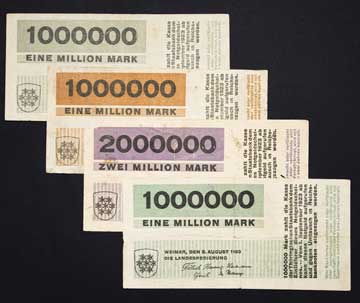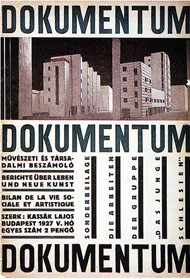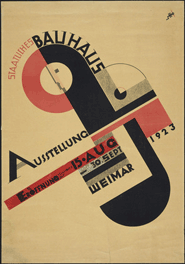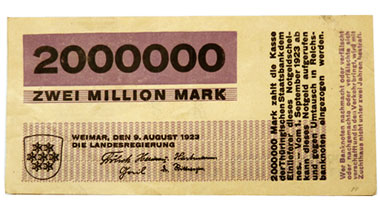Bauhaus
Link to Pinterest
The Bauhaus was a school whose approach to design and the combination of fine art and arts and crafts proved to be a major influence on the development of graphic design as well as much of 20th century modern art. Founded by Walter Gropius in Weimar, Germany in 1919, the school moved to Dessau in 1924 and then was forced to close its doors, under pressure from the Nazi political party, in 1933. The school favored simplified forms, rationality, functionality and the idea that mass production could live in harmony with the artistic spirit of individuality.
Along with Gropius, and many other artists and teachers, both Laszlo Moholy-Nagy and Herbert Bayer made significant contributions to the development of graphic design. Among its many contributions to the development of design, the Bauhaus taught typography as part of its curriculum and was instrumental in the development of sans-serif typography, which they favored for its simplified geometric forms and as an alternative to the heavily ornate German standard of blackletter typography.
The Bauhaus was a school whose approach to design and the combination of fine art and arts and crafts proved to be a major influence on the development of graphic design as well as much of 20th century modern art. Founded by Walter Gropius in Weimar, Germany in 1919, the school moved to Dessau in 1924 and then was forced to close its doors, under pressure from the Nazi political party, in 1933. The school favored simplified forms, rationality, functionality and the idea that mass production could live in harmony with the artistic spirit of individuality.
Along with Gropius, and many other artists and teachers, both Laszlo Moholy-Nagy and Herbert Bayer made significant contributions to the development of graphic design. Among its many contributions to the development of design, the Bauhaus taught typography as part of its curriculum and was instrumental in the development of sans-serif typography, which they favored for its simplified geometric forms and as an alternative to the heavily ornate German standard of blackletter typography.
Bauhaus Manifesto
Walter Gropius created the Staatliche Bauhaus in Weimar in 1919 from the merger of the Grand Ducal Saxonian school of arts and crafts, where Henry van de Velde was director until 1915, and the Grand Ducal Saxonian school of arts. Immediately after he took office as director, Gropius had a four-page pamphlet printed. He put Feininger’s Cathedral woodcut on the front page and included both the founding manifesto and a detailed teaching program in the content. This is where Gropius announced his school’s seminal aim: architecture, sculpture and painting were to lead back to the crafts. The name “Bauhaus” was selected for its allusion to the masons’ guilds of the medieval cathedrals, which combined art and craft in the collaborative undertaking, the “grand building”.

Cathedral
Feininger’s cubist woodcut, "Cathedral", was made in 1919 for the cover of Walter Gropius’s manifesto and programme for the Staatliches Bauhaus Weimar. Here, Gropius and Feininger referred to the “miracle of the Gothic cathedral” as a Gesamtkunstwerk (total work of art). The name “Bauhaus” subsequently evolved as an allusion to the medieval masons’ guilds.

Manifesto and Programme of the State Bauhaus
The Bauhaus’s incantatory ‘Manifesto’ formed part of the prospectus in which Walter Gropius presented the programme of the newly founded college of design in 1919, using Lyonel Feininger’s ‘Cathedral’ woodcut as the title image. The Bauhaus Director’s proclamation focuses on the need for the fine arts to be unified under the primacy of architecture and for a return to craftsmanship in order to reveal the ‘craft quality’ as the ‘ultimate source of creative design’.

Manifesto of the Staatliches Bauhaus in Weimar April 1919
“The ultimate goal of all art is the building! The ornamentation of the building was once the main purpose of the visual arts, and they were considered indispensable parts of the great building. Today, they exist in complacent isolation, from which they can only be salvaged by the purposeful and cooperative endeavours of all artisans. Architects, painters and sculptors must learn a new way of seeing and understanding the composite character of the building, both as a totality and in terms of its parts. Their work will then re-imbue itself with the spirit of architecture, which it lost in salon art.
The art schools of old were incapable of producing this unity – and how could they, for art may not be taught. They must return to the workshop. This world of mere drawing and painting of draughtsmen and applied artists must at long last become a world that builds. When a young person who senses within himself a love for creative endeavour begins his career, as in the past, by learning a trade, the unproductive “artist” will no longer be condemned to the imperfect practice of art because his skill is now preserved in craftsmanship, where he may achieve excellence.
Architects, sculptors, painters – we all must return to craftsmanship! For there is no such thing as “art by profession”. There is no essential difference between the artist and the artisan. The artist is an exalted artisan. Merciful heaven, in rare moments of illumination beyond man’s will, may allow art to blossom from the work of his hand, but the foundations of proficiency are indispensable to every artist. This is the original source of creative design.
So let us therefore create a new guild of craftsmen, free of the divisive class pretensions that endeavoured to raise a prideful barrier between craftsmen and artists! Let us strive for, conceive and create the new building of the future that will unite every discipline, architecture and sculpture and painting, and which will one day rise heavenwards from the million hands of craftsmen as a clear symbol of a new belief to come."
I am Currently Studying the Foundation of Art and design and the cause structure is based on the Bauhaus Manifesto








No comments:
Post a Comment